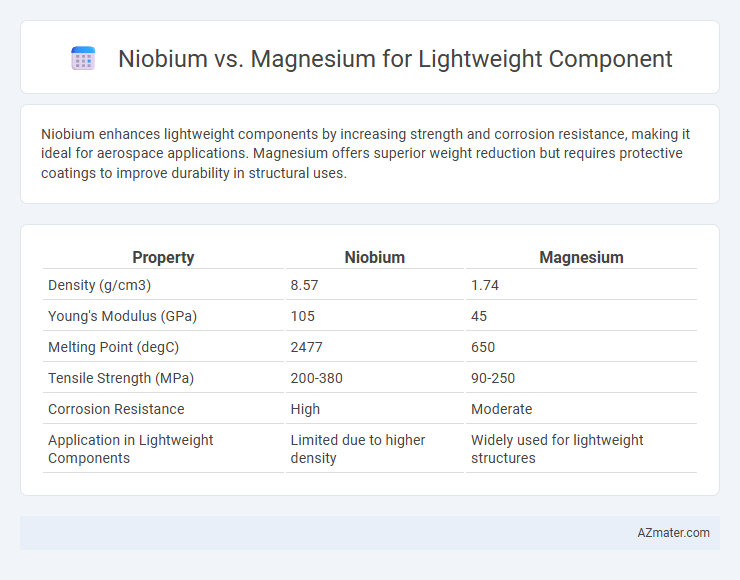Niobium enhances lightweight components by increasing strength and corrosion resistance, making it ideal for aerospace applications. Magnesium offers superior weight reduction but requires protective coatings to improve durability in structural uses.
Table of Comparison
| Property | Niobium | Magnesium |
|---|---|---|
| Density (g/cm3) | 8.57 | 1.74 |
| Young's Modulus (GPa) | 105 | 45 |
| Melting Point (degC) | 2477 | 650 |
| Tensile Strength (MPa) | 200-380 | 90-250 |
| Corrosion Resistance | High | Moderate |
| Application in Lightweight Components | Limited due to higher density | Widely used for lightweight structures |
Introduction to Lightweight Materials: Niobium vs Magnesium
Niobium and magnesium are critical materials in lightweight component manufacturing due to their distinct properties. Niobium offers high strength, excellent corrosion resistance, and good thermal stability, making it ideal for aerospace and automotive applications requiring durability. Magnesium provides exceptional lightness with a density of about 1.74 g/cm3, significantly lower than niobium's 8.57 g/cm3, making it advantageous for weight reduction despite lower strength and corrosion resistance.
Material Properties: Strength, Density, and Weight
Niobium offers high strength with a tensile strength around 380 MPa and a density of 8.57 g/cm3, resulting in heavier components compared to magnesium, which has a lower tensile strength of approximately 200 MPa but a significantly lower density of 1.74 g/cm3. Magnesium's superior strength-to-weight ratio makes it highly suitable for lightweight applications where minimizing mass is critical, whereas niobium is preferred in scenarios demanding enhanced strength and corrosion resistance despite added weight. The choice between niobium and magnesium hinges on balancing the critical factors of strength, density, and overall weight for optimized component performance.
Corrosion Resistance Comparison
Niobium exhibits superior corrosion resistance compared to magnesium, especially in harsh environments such as acidic or saline conditions, due to its stable oxide film that prevents surface degradation. Magnesium, while significantly lighter, tends to corrode rapidly when exposed to moisture and chloride ions, necessitating protective coatings for long-term durability. The enhanced corrosion resistance of niobium makes it a preferred choice for lightweight components in aerospace and marine applications where material longevity is critical.
Mechanical Performance in High-Stress Environments
Niobium exhibits superior mechanical strength and fatigue resistance compared to magnesium, making it ideal for lightweight components in high-stress environments such as aerospace and automotive sectors. Its excellent ductility and high melting point enhance durability under extreme thermal and mechanical loads. Magnesium offers lower density but falls short in tensile strength and corrosion resistance, limiting its application where mechanical performance is critical.
Thermal Conductivity and Heat Management
Niobium offers superior thermal conductivity compared to magnesium, enhancing heat dissipation in lightweight components used in aerospace and electronics. Magnesium's lower thermal conductivity makes it less effective at heat management but favorable due to its lighter weight and cost efficiency. The choice between niobium and magnesium depends on balancing thermal performance requirements with weight and budget constraints in design applications.
Manufacturing and Processing Techniques
Niobium offers superior strength-to-weight ratio and excellent weldability, making it ideal for advanced aerospace components requiring precise manufacturing processes such as powder metallurgy and additive manufacturing. Magnesium, while lighter, presents challenges in processing due to its high reactivity and poor corrosion resistance, often necessitating protective coatings and specialized casting techniques like die casting or extrusion. The choice between niobium and magnesium depends on balancing manufacturing complexity with component performance, where niobium supports high-performance, high-temperature applications and magnesium excels in cost-sensitive, bulk lightweight structures.
Cost Analysis of Niobium and Magnesium
Niobium offers superior strength-to-weight ratio but comes at a higher cost, averaging $40-50 per kilogram compared to magnesium's $2-3 per kilogram, making magnesium more cost-effective for lightweight components. Despite higher material costs, niobium's enhanced durability and corrosion resistance can reduce long-term maintenance expenses, justifying its use in high-performance applications. Magnesium's affordability and lower density remain attractive for mass-produced lightweight components where budget constraints are critical.
Environmental Impact and Sustainability
Niobium enhances the strength-to-weight ratio of steel alloys, enabling thinner, lighter components that reduce overall material consumption and improve fuel efficiency in vehicles, thereby lowering carbon emissions throughout the product lifecycle. Magnesium, known for its extremely low density, offers significant weight reductions but raises concerns due to its energy-intensive extraction process and recyclability challenges, which can increase environmental impact compared to niobium-strengthened steels. Sustainable lightweight design leveraging niobium steel alloys promotes longer-lasting components with higher recyclability rates, aligning better with circular economy principles and reducing ecological footprint over magnesium-based alternatives.
Industrial Applications: Automotive, Aerospace, and Beyond
Niobium offers superior strength-to-weight ratio and excellent corrosion resistance, making it ideal for automotive and aerospace lightweight components that demand durability and performance under extreme conditions. Magnesium, noted for its ultra-lightweight properties, is favored in applications where weight reduction is critical but structural strength is less stringent, such as in interior automotive parts and aerospace non-structural elements. Industrial sectors leverage Niobium's ability to enhance steel and alloy performance, while Magnesium's recyclability and cost-effectiveness support sustainable manufacturing trends beyond transportation industries.
Future Trends and Innovations in Lightweight Components
Niobium's exceptional strength-to-weight ratio and corrosion resistance make it a key material in advanced lightweight components, particularly in aerospace and automotive sectors focused on fuel efficiency and sustainability. Magnesium, valued for its ultra-lightweight properties and recyclability, is seeing innovations in alloying techniques that enhance mechanical performance and thermal stability. Future trends highlight hybrid materials combining niobium and magnesium alloys, leveraging their complementary properties to push the boundaries of lightweight structural design and performance.

Infographic: Niobium vs Magnesium for Lightweight Component
 azmater.com
azmater.com